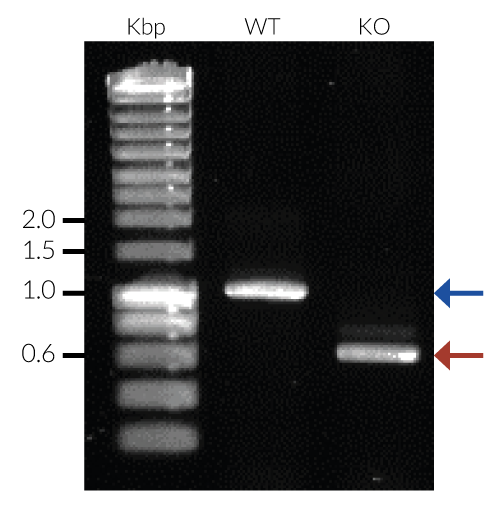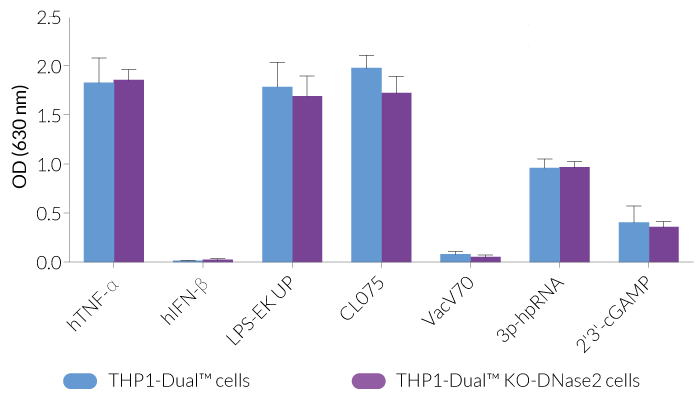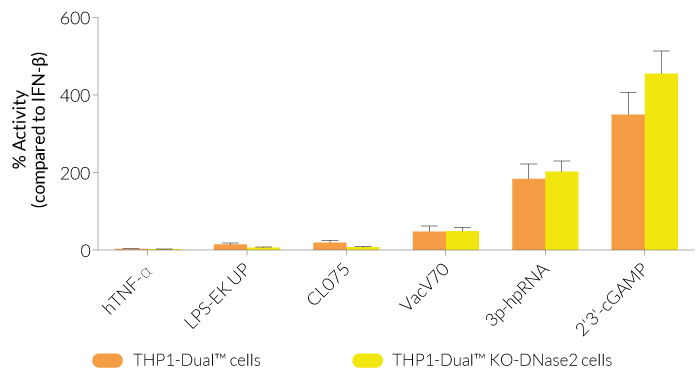THP1-Dual™ KO-DNase2 Cells
| Product | Unit size | Cat. code | Docs. | Qty. | Price | |
|---|---|---|---|---|---|---|
|
THP1-Dual™ KO-DNase2 Cells Human THP-1 Monocytes - DNAse2 knockout NF-κB-SEAP and IRF-Lucia Reporter Cells |
Show product |
3-7 x 10e6 cells |
thpd-kodnase2
|
|
||
|
THP1-Dual™ KO-DNase2 vial Additional cell vial |
Show product |
3-7 x 10e6 cells |
thpd-kodnase2-av
|
Notification: Reference #thpd-kodnase2-av can only be ordered together with reference #thpd-kodnase2.
DNase2 knockout NF-κB-SEAP and IRF-Lucia luciferase reporter monocytes

Signaling pathways in THP1-Dual™ KO-DNase2 Cells
THP1-Dual™ KO-DNase2 cells were generated from THP1-Dual™ cells by stable biallelic knockout of the DNASE2 gene. Human THP1 monocytes or derived macrophages are a common cellular model to study DNA sensing as they naturally express all cytosolic DNA sensors identified so far (except DAI). THP1-Dual™ KO-DNase2 cells feature two inducible reporter genes allowing the concomitant study of the IRF and NF-κB pathways, by monitoring the Lucia luciferase and SEAP (secreted embryonic alkaline phosphatase) activities, respectively.
DNase2 (Deoxyribonuclease 2) is a lysosomal endonuclease present in macrophages. It exerts an important function in clearing DNA from phagocytosed apoptotic cells and from maturating erythroblast nuclei [1,2].
Key features:
- Biallelic knockout of the DNASE2 gene
- Functionally validated with a selection of PRR ligands and cytokines
- Readily assessable Lucia luciferase and SEAP reporter activities
Applications:
- Study of IRF and NF-kB-dependent DNase2 signaling pathways
- Screening of interactions between DNase2 and other signaling protein
- Study the role of DNase2 in innate immunity
1. Kawane K. et al., 2014. DNA degradation and its defects. Cold Spring Harb Perspect Biol. Jun 2;6(6).
2. Crow Y.Z. & Stetson D.B., 2021. The type I interferonopathies: 10 years on. Nat Rev Immunol. Oct 20:1–13.
Specifications
Growth medium: RPMI 1640, 2 mM L-glutamine, 25 mM HEPES, 10% heat-inactivated fetal bovine serum, 100 U/ml Penicillin, 100 μg/ml Streptomycin, 100 μg/ml Normocin™
Antibiotic resistance: Zeocin®, Blasticidin
Quality control:
- Biallelic DNASE2 gene knockout has been verified by PCR, DNA sequencing, and functional assays.
- The stability of this cell line for 20 passages following thawing has been verified.
- THP1-Dual™ KO-DNase2 cells are guaranteed mycoplasma-free.
Contents
- 1 vial of THP1-Dual™ KO-DNase2 cells (3-7 x 106 cells) in a cryovial or shipping flask
- 1 ml of Normocin™ (50 mg/ml). Normocin™ is a formulation of three antibiotics active against mycoplasmas, bacteria, and fungi.
- 1 ml of Zeocin® (100 mg/ml)
- 1 ml of Blasticidin (10 mg/ml)
- 1 tube of QUANTI-Luc™ 4 Reagent, a Lucia luciferase detection reagent (sufficient to prepare 25 ml)
- 1 ml of QB reagent and 1 ml of QB buffer (sufficient to prepare 100 ml of QUANTI-Blue™ Solution, a SEAP detection reagent)
![]() Shipped on dry ice (Europe, USA, Canada and some areas in Asia)
Shipped on dry ice (Europe, USA, Canada and some areas in Asia)
Details
DNase2 (alternatively known as DNase II, DNase2a, or Acid DNase) is an endonuclease critical in cellular health and development.
It is localized in the lysosome of macrophages and shows peak activity at an acidic pH [2]. This enzyme is involved in DNA metabolism: it digests exogenous DNA of apoptotic cells and DNA of nuclei expelled from erythroid precursors [1]. Like TREX1, another critical nuclease also known as DNase III, DNase2 helps to rapidly remove nucleic acid fragments to prevent cells from accumulating self-DNA in the cytosol and triggering autoimmunity [3].
Defects in DNase2 functions allow undigested DNA fragments to leak into the cytosol and trigger the STING-TBK1-IRF3 signaling pathway [1]. As a consequence, pro-inflammatory cytokines (e.g., IFN-β) are constitutively expressed, causing interferonopathies and other autoimmune disease phenotypes (e.g. severe anemia, arthritis) [2,4].
1. Rodero et al., 2017. Type I interferon-mediated autoinflammation due to DNase II deficiency. Nat Commun 8, 2176.
2. Keyel, 2017. Dnases in health and disease. Developmental Biology 429(1).
3. Lan, Y.Y. et al., 2014. “Dnase2a deficiency uncovers lysosomal clearance of damaged nuclear DNA via autophagy.” Cell reports vol. 9,1: 180-192.
4. Crow, Y.J. &Stetson, D.B. 2021. The type I interferonopathies: 10 years on. Nat Rev Immunol.










